With over 3000 hours of sunshine per year, Spain is one of Europe’s most sought-after holiday destinations. Travelers from all over the world choose this Mediterranean country to rest and get in touch with its vibrant culture, attracted by the warm weather and wonderful beaches. With almost 5,000 kilometers of coastline, without counting the islands, it is easy to find long sandy beaches with a turquoise sea that invites hours of relaxation on the sunloungers, with various support services, and a lively atmosphere. However, Spain has coastal regions made for every taste.
Enjoying the sea in Spain is more than just unwinding on the shore. It is also about wandering in small villages, hiking with spectacular views, tasting fresh fish by the port, and contemplating the landscape with the most beautiful sunsets. It means disconnecting from the world and letting yourself be conquered by natural beauty. Spain has some coastal regions that remain undiscovered by the mainstream international tourism, allowing them to preserve their authentic feel and incredible natural beauty.
Join us on a journey to discover the unspoiled beauty of Spain's coastal regions, where you can fulfill your dream of walking along a deserted beach and feeling like the first person to ever discover it!
Mojácar
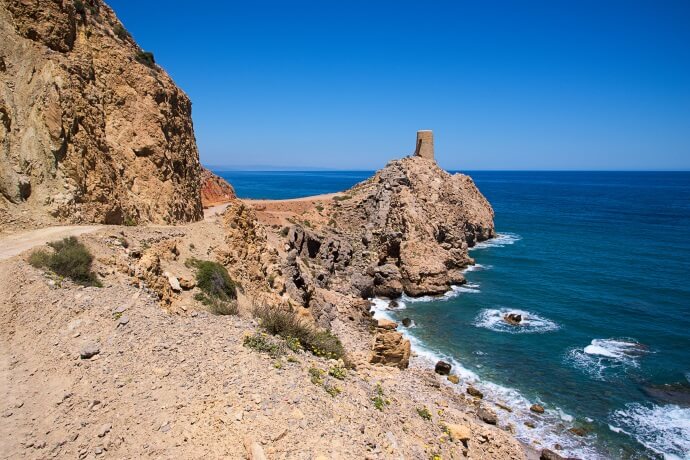
This is one of the most charming villages on the east coast of Almeria, located on the hill of the Sierra Cabrera. Think of an enchanting town near the sea, with white houses, wonderful beaches, and stunning landscapes. The architecture of Arab origin preserves a structure of stepped balconies, small corners, and narrow streets filled with colorful flowers. So, it is a pleasure to wander and find its monuments, like the Renaissance church of Santa María, the castle of Mojácar, the city gate, and the tower - the only remains of the old wall. Or you can just chill on one of the many terraces of restaurants and bars and watch the world go by.
A short drive from Mojácar is Cabo de Gata, a cape that is part of the Natural Park of Cabo de Gata-Níjar. This is one of the most beautiful stretches of the Spanish coastline, with clear water and white sand. It is definitely worth taking some time to unwind in this piece of paradise on earth. Next to the Cabo de Gata Lighthouse is the Mirador de las Sirenas, which is the best place to enjoy the spectacular views of the turquoise water, the reef, and the rocks jutting out of the water.
For a complete change of scenery, you can take the opportunity to explore Europe’s only desert, the Tabernas Desert. Here the sun shines for more than 3000 hours a year over 280 kilometers square and there is hardly any rain. This astonishing landscape with its windswept rocks and cliffs was the perfect setting for some of Hollywood’s western movies made at the end of the 20th century.
Costa Brava
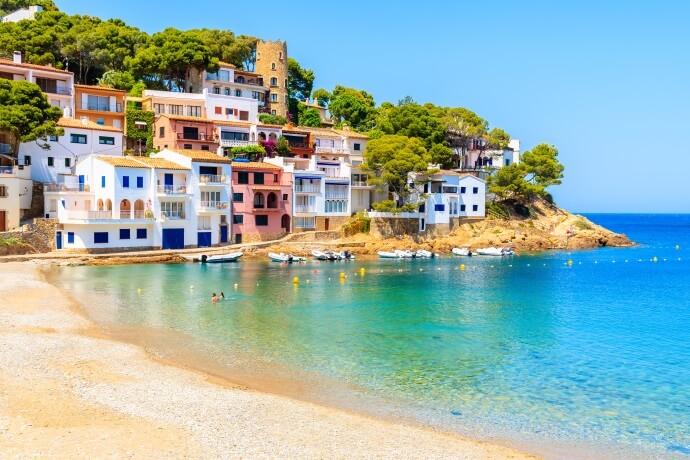
With plenty of paradisiacal beaches and picturesque towns to explore, all within a 30-minute drive or less, the Costa Brava looks like a postcard. Situated in the province of Girona, it is a scenic stretch of Catalan coastline that runs from the north of Barcelona to the French border. Its name literally means “wild coast”, a reference to the spectacular cliffs and hundreds of coves that line the coast. There are dozens of places in Costa Brava that compete for the title of the perfect setting for holidays: from authentic fishing villages to medieval towns with castles facing the sea and stunning nature reserves.
Begur is a nice choice for a base to explore Costa Brava. It is an ancient village on top of a hill with an old fortification, small enough for you to fully explore the quirky colorful streets and alleys by foot or just relax in the town squares. Climb to the top of the fortification for panoramic picture-perfect views of the entire region. In Begur you will find some of the best beaches of Costa Brava, like Aiguablava and Sa Tuna, with turquoise blue water that invites for a swim and idyllic places to sunbathe. For a bit of history and a chance to learn about the city, visit the Roman ruins of Empúries.
Nerja
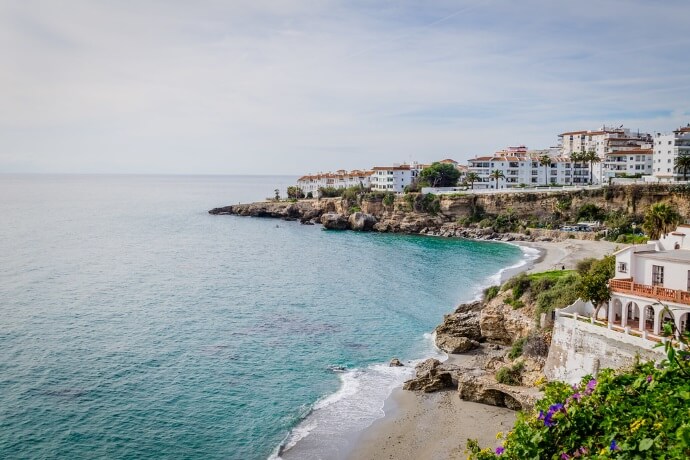
This is probably one of Costa del Sol’s most popular beach resorts for many reasons: it has Spanish charm, picturesque architecture, great food, a relaxing atmosphere, and, of course, amazing beaches. Located in Andalusia, just an hour away from Málaga, this inviting village with whitewashed houses and iron balconies has incredible views of a rocky coastline, stretches of sand, and cute coves. And yes, you will feel invited to experience Nerja's beaches' powdery sand and crystal-clear waters, like Burriana and Torrecilla.
Nerja’s old town is like an entanglement of precious little streets with shops and bars, and be sure to explore the heart of the town, which is Balcon de Europa or Europe’s Balcony. Built where once stood a fortress, destroyed during the War of Independence, in the early 19th century, it is now a circular terrace offering panoramic views over the coast and is especially perfect at sunset. This is the town’s main promenade with a lively and relaxing atmosphere, ideal for just sitting back and appreciating the breathtaking views. To rest a little from the strong Spanish sun, you can descend underground to the Nerja Caves. Only visitable with a guided tour, it’s also the stage for music events during summer.
Costa da Morte
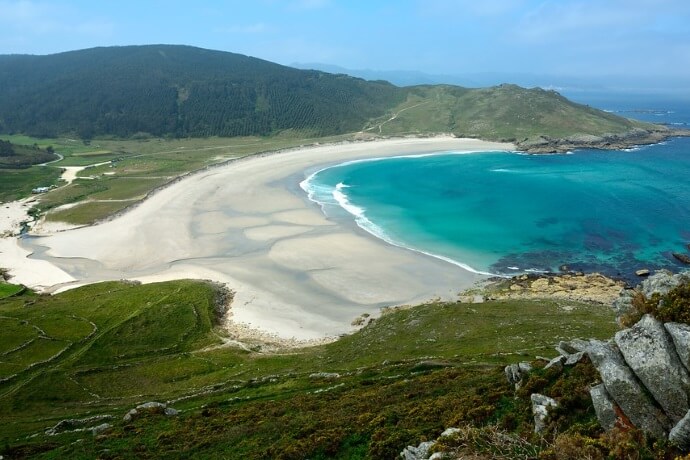
With a name that literally means Death Coast, Costa da Morte is as wild as it seems, with dramatic cliffs, forests, estuaries, and lighthouses. Relatively remote and away from easy access by major roads, Costa da Morte remains an area of Galicia that nature owns and masters. Its name and reputation come from many shipwrecks that occurred along its impressive rocky coast exposed directly to the Atlantic Ocean. However, it is a place calling for peaceful moments of contemplation of its wild beauty.
From desolate coves to big sandy beaches, you have many options to choose from, but the weather can be a little tricky and the sea a bit too rough for swimming, even in summer. However, the Costa da Morte has many possibilities for you to unveil besides its beaches. Here you will find a unique 3-day ocean trekking experience, the Ruta de los Naufragios, that goes from the village of Camariñas to the lighthouse at Laxe (Lage). For a feeling of solitude, there is no place like Finisterre, where ancient people believed the world ended and indeed it is the culmination of the Camiño de Santiago after reaching Santiago de Compostela. In this stretch of land “at the end of the world”, with its lighthouse, with the wind blowing against your face, you will feel all the power of nature.
But the Costa da Morte is much more than an impressive coastline. Its picturesque fishing villages are a great place to relax and taste some of the best Spanish gastronomy: seafood! Choose one of the many unpretentious restaurants to try the highly sought-after gooseneck barnacles and the traditional Galician octopus.
Ribadeo
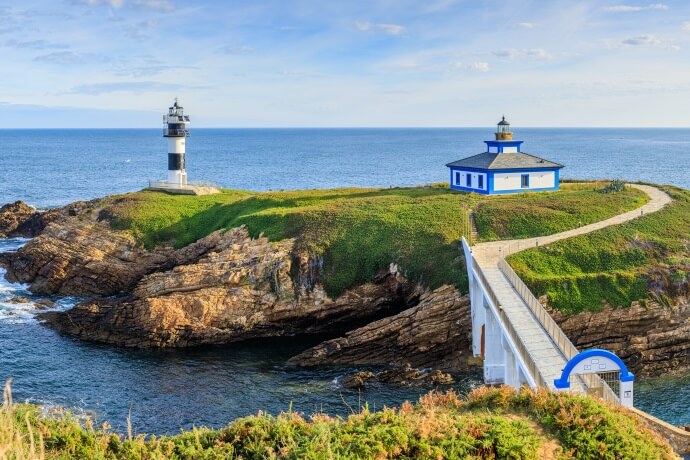
In the majestic Cantabrian Coast, near the frontier of Galicia with Asturias, you will find a town with sailor flavor, peculiar Indian houses, and stunning natural beauty in its surroundings. This small village near Lugo is one of its kind in all of Spain, with one of the most beautiful historic centers of Galicia, due to its colorful buildings inspired by the Indian style. In the San Roque Quarter, you will also find this picturesque architecture built by emigrants from the town and the surrounding area, combining modernist styles and architecture of cities like Havana.
The postcard from Ribadeo is, however, its famous beach, the Playa de las Catedrales - the perfect example of the natural beauty of Spain. Here you will find rock formations carved by waves and wind that resemble a cathedral in a unique masterpiece made by the sea. To make the most of your visit you will have to prepare it in advance, because it is necessary to request permission to visit the beach during the high season. Also, check what time the low tide is, as if you go with a high tide, you won’t be able to see the incredible rock formations that made the beach so popular.
Although less remarkable, the Playa dos Xuncos, Playa dos Castros, Playa das Illas, and Playa de Esteiro are the perfect alternative for Playa de las Catedrales. Their access is free and some have rock formations as spectacular as the Cathedrals.
Spain is always a good idea!
The lively cities and the many trendy beaches are some of the favorite destinations of the numerous tourists who choose Spain every year to spend their holidays. However, this country bordered by the Atlantic Ocean to the north and the Mediterranean Sea to the south has much more to offer than those famous places. From small villages that seem to have stopped in time, to rocky and semi-deserted areas with rough seas, Spain has areas with such natural beauty that looks like not yet been touched by the human hand. So, even if you already visited Spain, you are now aware of the plenty more destinations there are still to discover in this astonishing country. And we are happy to advise you and create together a perfect holiday!



